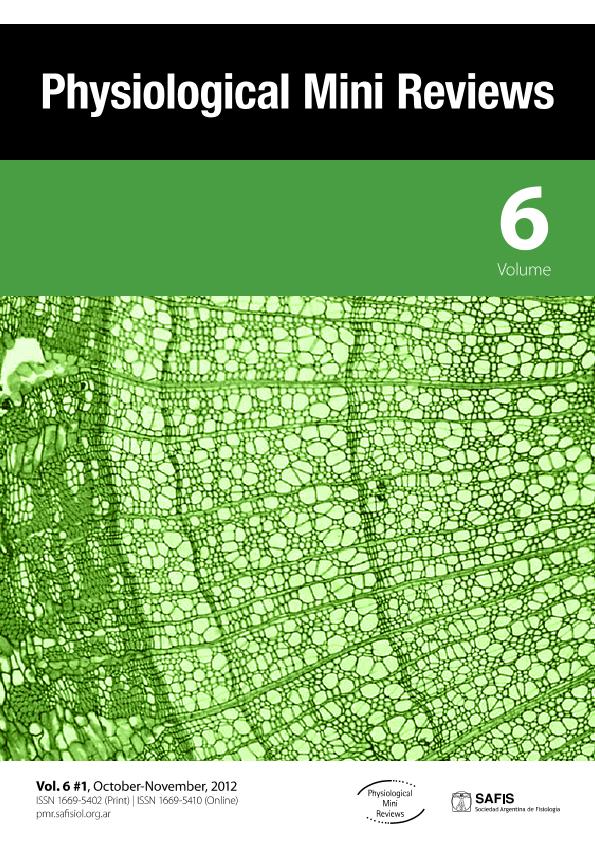Mostrar el registro sencillo del ítem
dc.contributor.author
Pardo, Joaquin

dc.contributor.author
Schwerdt, José Ignacio

dc.contributor.author
Reggiani, Paula Cecilia

dc.contributor.author
Zappa, María Eugenia

dc.contributor.author
Pereyra, Andrea Soledad

dc.contributor.author
Brown, Oscar Alfredo

dc.contributor.author
Goya, Rodolfo Gustavo

dc.date.available
2020-04-06T20:52:29Z
dc.date.issued
2012-10
dc.identifier.citation
Pardo, Joaquin; Schwerdt, José Ignacio; Reggiani, Paula Cecilia; Zappa, María Eugenia; Pereyra, Andrea Soledad; et al.; Physiology, molecular biology and therapeutic potential of the thymic peptide thymulin; Sociedad Argentina de Fisiología; Physiological Mini Reviews; 6; 1; 10-2012; 2-12
dc.identifier.issn
1669-5410
dc.identifier.uri
http://hdl.handle.net/11336/102114
dc.description.abstract
Thymulin is a thymic hormone exclusively produced by the thymic epithelial cells. After its discovery and initial characterization in the ‘70s, it was demonstrated that thymulin production and secretion is strongly influenced by the neuroendocrine system. Conversely, a growing core of information, to be reviewed here, points to thymulin as a hypophysiotropic peptide. Additionally, the substantial body of evidence pointing to thymulin and some synthetic analogs as anti-inflammatory and analgesic molecules in the brain and other organs will be also reviewed. In recent years, a synthetic DNA sequence coding for a biologically active analog of thymulin, metFTS, was constructed and cloned in different adenoviral vectors. A number of recent studies suggest that thymulin gene therapy may be a suitable therapeutic strategy to prevent some of the endocrine and reproductive alterations that typically appear in congenitally athymic (nude) mice, used as a suitable model of neuroendocrine and reproductive aging. Summing up, the present article briefly reviews the literature on the physiology of the thymulin-neuroendocrine axis and the anti-inflammatory properties of the molecule and its analogs. The availability of novel biotechnological tools should boost basic studies on the molecular biology of thymulin and should also allow an assessment of the potential of gene therapy to restore circulating thymulin levels in thymodeficient animal models and eventually, in humans.
dc.format
application/pdf
dc.language.iso
eng
dc.publisher
Sociedad Argentina de Fisiología
dc.rights
info:eu-repo/semantics/openAccess
dc.rights.uri
https://creativecommons.org/licenses/by-nc-sa/2.5/ar/
dc.subject
Thymulin
dc.subject
Neuroendocrine Control
dc.subject
Hypophysiotropic Activity
dc.subject
Artificial Gene
dc.subject
Gene Therapy
dc.subject
anti-inflammatory
dc.subject
ovarian dysgenesis
dc.subject.classification
Otras Medicina Básica

dc.subject.classification
Medicina Básica

dc.subject.classification
CIENCIAS MÉDICAS Y DE LA SALUD

dc.title
Physiology, molecular biology and therapeutic potential of the thymic peptide thymulin
dc.type
info:eu-repo/semantics/article
dc.type
info:ar-repo/semantics/artículo
dc.type
info:eu-repo/semantics/publishedVersion
dc.date.updated
2019-04-26T18:18:52Z
dc.identifier.eissn
1669-5410
dc.journal.volume
6
dc.journal.number
1
dc.journal.pagination
2-12
dc.journal.pais
Argentina

dc.journal.ciudad
Ciudad Autónoma de Buenos Aires
dc.description.fil
Fil: Pardo, Joaquin. Consejo Nacional de Investigaciones Científicas y Técnicas. Centro Científico Tecnológico Conicet - La Plata. Instituto de Investigaciones Bioquímicas de La Plata "Prof. Dr. Rodolfo R. Brenner". Universidad Nacional de la Plata. Facultad de Ciencias Médicas. Instituto de Investigaciones Bioquímicas de La Plata "Prof. Dr. Rodolfo R. Brenner"; Argentina
dc.description.fil
Fil: Schwerdt, José Ignacio. Consejo Nacional de Investigaciones Científicas y Técnicas. Centro Científico Tecnológico Conicet - La Plata. Instituto de Investigaciones Bioquímicas de La Plata "Prof. Dr. Rodolfo R. Brenner". Universidad Nacional de la Plata. Facultad de Ciencias Médicas. Instituto de Investigaciones Bioquímicas de La Plata "Prof. Dr. Rodolfo R. Brenner"; Argentina
dc.description.fil
Fil: Reggiani, Paula Cecilia. Consejo Nacional de Investigaciones Científicas y Técnicas. Centro Científico Tecnológico Conicet - La Plata. Instituto de Investigaciones Bioquímicas de La Plata "Prof. Dr. Rodolfo R. Brenner". Universidad Nacional de la Plata. Facultad de Ciencias Médicas. Instituto de Investigaciones Bioquímicas de La Plata "Prof. Dr. Rodolfo R. Brenner"; Argentina
dc.description.fil
Fil: Zappa, María Eugenia. Consejo Nacional de Investigaciones Científicas y Técnicas. Centro Científico Tecnológico Conicet - La Plata. Instituto de Investigaciones Bioquímicas de La Plata "Prof. Dr. Rodolfo R. Brenner". Universidad Nacional de la Plata. Facultad de Ciencias Médicas. Instituto de Investigaciones Bioquímicas de La Plata "Prof. Dr. Rodolfo R. Brenner"; Argentina
dc.description.fil
Fil: Pereyra, Andrea Soledad. Consejo Nacional de Investigaciones Científicas y Técnicas. Centro Científico Tecnológico Conicet - La Plata. Instituto de Investigaciones Bioquímicas de La Plata "Prof. Dr. Rodolfo R. Brenner". Universidad Nacional de la Plata. Facultad de Ciencias Médicas. Instituto de Investigaciones Bioquímicas de La Plata "Prof. Dr. Rodolfo R. Brenner"; Argentina
dc.description.fil
Fil: Brown, Oscar Alfredo. Consejo Nacional de Investigaciones Científicas y Técnicas. Centro Científico Tecnológico Conicet - La Plata. Instituto de Investigaciones Bioquímicas de La Plata "Prof. Dr. Rodolfo R. Brenner". Universidad Nacional de la Plata. Facultad de Ciencias Médicas. Instituto de Investigaciones Bioquímicas de La Plata "Prof. Dr. Rodolfo R. Brenner"; Argentina
dc.description.fil
Fil: Goya, Rodolfo Gustavo. Consejo Nacional de Investigaciones Científicas y Técnicas. Centro Científico Tecnológico Conicet - La Plata. Instituto de Investigaciones Bioquímicas de La Plata "Prof. Dr. Rodolfo R. Brenner". Universidad Nacional de la Plata. Facultad de Ciencias Médicas. Instituto de Investigaciones Bioquímicas de La Plata "Prof. Dr. Rodolfo R. Brenner"; Argentina
dc.journal.title
Physiological Mini Reviews
dc.relation.alternativeid
info:eu-repo/semantics/altIdentifier/url/https://pmr.safisiol.org.ar/archive/id/54
Archivos asociados
